Hello fellow enthusiasts,
At the end of October and early November, I was visiting Korea - which is where my wife is from. I had a chance to sample life in Seoul and around the countryside along with a fair bit of driving. Since Korea is now one of the handful of dominant automotive nations of the world, I decided I'd share my views and experiences with you about driving in Korea and what the scene looks like.
The Basics
Korea is represented globally by Hyundai and Kia and, to an extent Ssangyong. Furthermore, a clutch of Chevrolet models, actually out of the Daewoo family, although now absent from India, are still popular in many global markets. Fair to say then that as an auto enthusiast and and Indian, I was curious to see what's what.
Mass Patriotism
What struck me almost immediately was how many Korean cars they drive. While this may seem obvious, the lack of other countries represented in the mass market is stunning. I spent the bulk of my trip in a Kia K3 belonging to my mother-in-law. That car is known as the Kia Forte and is the sister car of the Hyundai Elantra for us in India. There are literally thousands of the same car on the streets of Seoul and the rest of the country. However, in my 16 day visit, I saw a total of
One Honda Civic and
Zero Toyota Corollas, both in the same size market as the Kia. Literally every car was a Hyundai, Kia, Renault Samsung, Ssangyong or Chevrolet, which is Daewoo in disguise. The only exception to this Korean rule comes from Germany. Volkswagen are fairly popular with the Golf, the only sort of mass market car that wasn't Korean. I guess, more recently, Renault Samsung models have been introduced that are from the EU portfolio including the Captur, Talisman and Koleos. In the luxury space, Hyundai, Kia and Genesis fight with BMW and Mercedes, with Audi a bit further back. Clearly, if you're in Korea, it's either Korean or German -
nothing else.
The mass market car segment is an all Korean affair.

For a country that is so exposed to the world and sells its brands across pretty much every country, I found this to be quite interesting. The same is not true in other product related industries - there are plenty of Japanese clothing brands, French beauty brands, all the Zara's & H&M's etc. They even love the iPhone regardless of the fact that Samsung and LG are domestic giants. The auto industry seems to be the only place where such a situation exists.
Renault Koleos II aka Renault Samsung QM6

Cars seem to be split evenly between diesel and petrol. I saw a lot of larger Hyundais & Kias with VGT badges on them along with VW TDI's and BMW/Mercedes 'd' versions. Jeju Island, off the south coast, has a lot of electric vehicles including the Hyundai Ioniq and BMW i3, but no Toyota Prius once again showing the Korean or German preference. Charging infrastructure there is good.
Commercial Vehicles
The CV Market is also dominated by Korean players Hyundai & Kia with Tata-Daewoo also visible to an extent. Korean buses have funny names like the Kia Grandbird Parkway or the Hyundai Universe Noble.
A bunch of Kia Grandbird Parkway Buses. The CV market is totally Korean dominated.
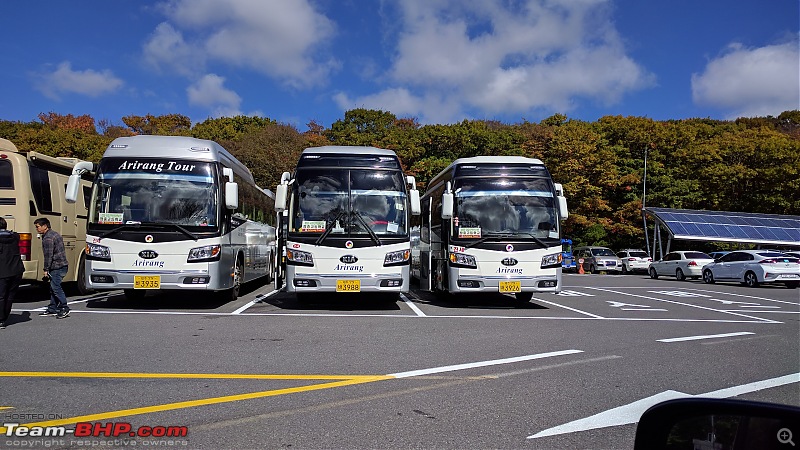
A Tata Daewoo Rental Car Shuttle Bus. I like the half-Tata, half-Daewoo logo.
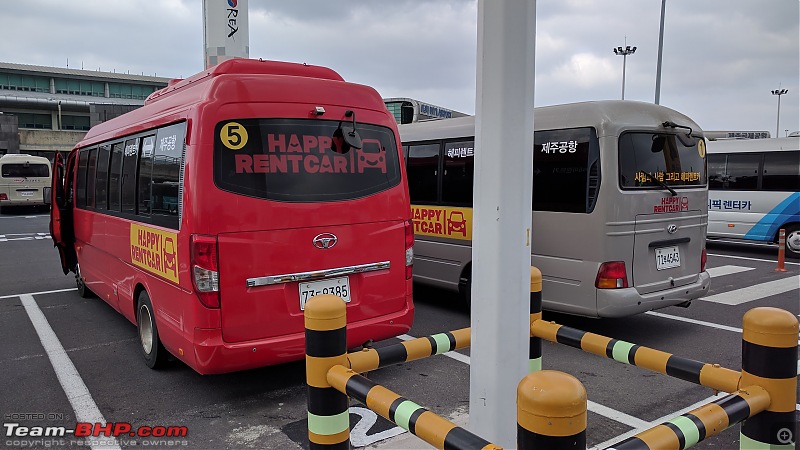
An interesting thing for me was the 1-ton tempo market. Here you get a Kia Bongo or Hyundai Porter. The most common version I saw was the CRDI version with 130 hp and a 6 speed manual. Tata Ace drivers, eat your hearts out!! This vehicle is simply wayyyy too powerful for its own good and can easily zoom past you on the highway even if you're cruising at 120 km/h. Another interesting fact is that the wheel size is different front and rear on both these vehicles. The front has a 195/70/R15 wheel/tyre size combination whereas the rear has two pairs of 155/70/R12 wheel/tyre size combination. This means that each vehicle has to have two spare tyres for either front or rear. An odd combination, no doubt. I have heard of different widths for front and rears on the same rim, but had never seen this before.
Kia Porter 1-ton truck. R15 wheels up front, R12 at the rear. How odd!
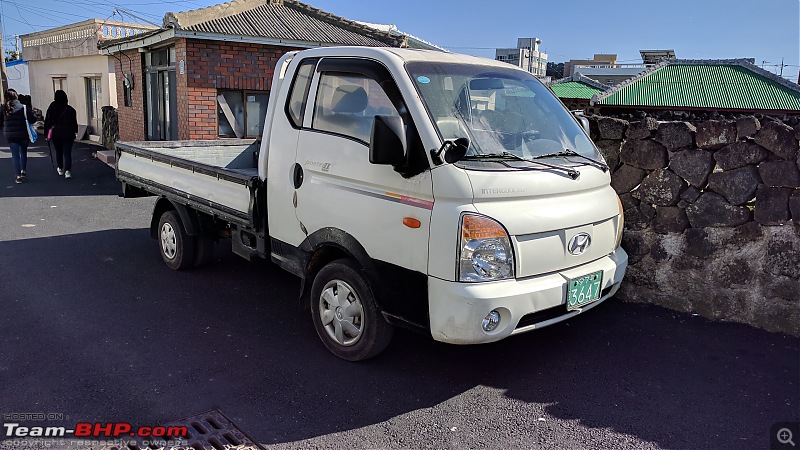 Transport & The Road System
Transport & The Road System
Korea is a mecca for public transport. The Seoul Metro system has over 300 stations, 600+ if you count stations with 2+ lines. An overall system length over 1000 km. It is a true urban work of art. Every station has platform doors that open simultaneously with the train doors. A/C & Heating in every train and seats of the train as well. Automatic train control. The works. Add to this, Busan - the 2nd city, has 135 stations at last count. Furthermore, Seoul has a huge bus network with BRT lanes, live status of buses and they even tell you if the bus is full while you wait at your stop. Taxis accept the same method of payment as subway and buses.
Korea also has a long distance train network with various different types of trains, the top being the TGV (France) derived KTX. I had the fortune of travelling at 300 km/h on a 200 km trip that took just under an hour.
Add all of this up and you wonder why people own cars, but they do - in their thousands. Seoul traffic can make some of our Bombay or Delhi jams seem like amateur stuff. Add a few combinations of bad luck and you can easily spend 1 or 2 hours in a jam.
The road system is fantastic. I barely felt a pothole and everything is marked in both Korean and English. Google Maps does
not work due to disagreements with the government over data privacy. Local softwares do work, but in Korean. Thankfully between my beginner level language knowledge and my wife's native knowledge, we managed just fine. All GPS systems have alerts for speed cameras, school zones and speed breakers. On the highways, you can tell that literally everyone has GPS - they all slow down simultaneously when a speed camera warning pops up. Companies like VW have integrated the local sat-nav software into their Infotainment systems so that they work well.
Highway and road markings are innovative. If, for example, there are two different destinations that you can access from an exit on the highway, the lanes will be painted in the colour that corresponds to that route - the same will show on the signboards and direction hoardings. Pink lane if you want to go to A, Green lane if you want to go to B. Smart. There is also an abundant use of red rough textured paint to warn of upcoming turns or dangerous sections, particularly on Jeju Island which is a volcanic island resort, Korea's Hawaii if you will. The same is illustrated in the video below.
http://www.youtube.com/watch?v=DUDu8FSwa90
Korea is also a world leader in tunneling. On our drive, we went through the new Inje Tunnel which is 11 km long. Unfortunately for filming purposes, I was driving, wife was sleeping - so no video! The tunnel itself is beautifully made with regular emergency exits. It is intentionally made with slight curves to prevent long straight sections that can lead to distracted driving. Lanes before and within the tunnel are grooved at different places to create tyre noise and keep you alert. There is even a section where the grooves play the tune to Twinkle Twinkle Little Star. No, I am not joking. Various sections have coloured LED lights along the walls to keep you attentive and even sections with painted designs on the roof. All of these led to a healthy level of attention and an enjoyable peaceful drive. Marvelous.
Korea is a heavily mountainous country. Apart from the highways blasted through tunnels, most side roads are hilly, windy, twisty and absolutely bloody brilliant! How such a country produces boring-to-drive cars is totally beyond me. Those roads beg for a fun hot hatch or sports car. Fortunately, I did have an experience with a Golf GTI - more on that later.
Cars That I Drove 1. Kia K3 aka Forte aka Hyundai Elantra 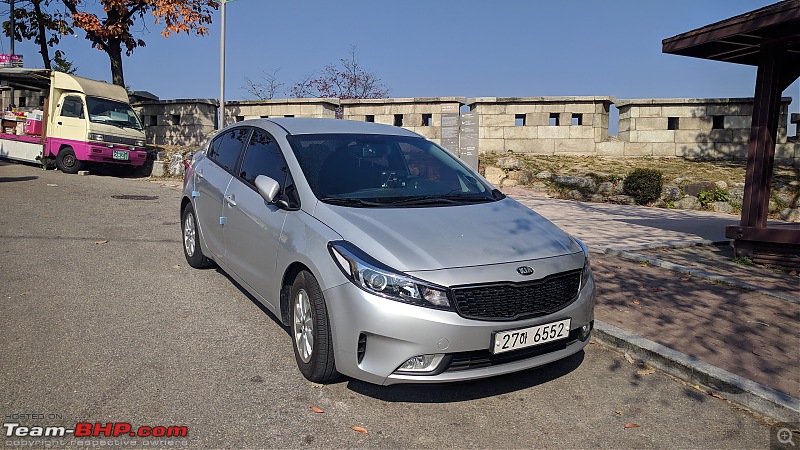 Likes
Likes:
1. Ride quality on 195/65/R15 tyres
2. Fuel Economy from the 1.6 L petrol/6 speed auto of close to 20 km/l on a 600 km drive through highways, hills and country roads.
3. Interior space and comfortable seats.
Dislikes:
1. Lifeless steering - I had some entertaining roads, but no fun.
2. Gutless powertrain - 132 hp with a 6-Auto slushbox is just adequate.
It's fair to say this car is a device for point A to B. A lesson in how to introduce mediocrity to excellent roads.
2. Kia Ray - Korea's resident tall-boy  Likes:
Likes:
1. Interior space that makes a Passat seem cramped!
2. Ride quality not as bad as expected from a tiny tall boy
3. Relatively controlled body roll for such a high car with small wheels.
Dislikes
1. Puny 3-cylinder 1.0L engine with 4-speed auto. Claims 75 hp but probably 45 were on strike. 0-100 in never.
2. Atrocious hill climbing lack of capability. I drove in manual mode most of the time and kept having to hit 5,000 rpm to get anywhere.
3. Aerodynamics of a brick wall. Shook around every time a small gust of wind came.
4. Woeful 13.9 km/l over 400 km of easy-going smooth driving
5. No boot space beyond a weekend bag.
Perhaps the 107,000 km on our rental explains the weak engine and fuel economy.
3. VW Golf Mark 7 GTI 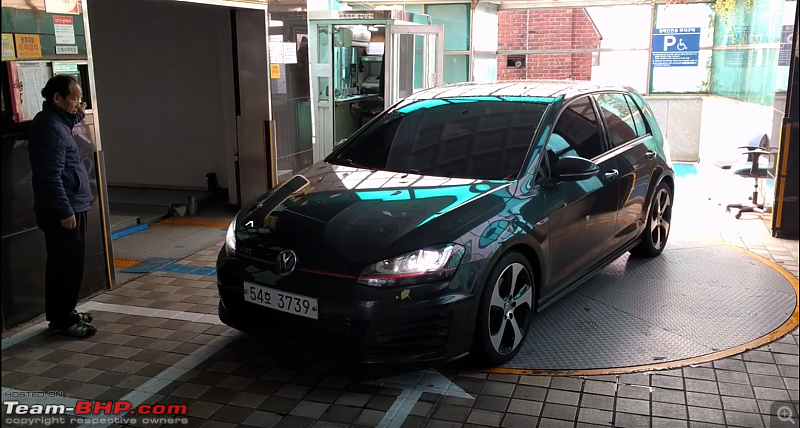 Likes:
Likes:
1. Oh boy - ultra responsive turbo 2.0 with snappy DSG. Easy to break the speed limit in the blink of an eye. Sounds sweet too for a 4-banger.
2. Instant overtaking on single lane country roads.
3. Split personality between a thoroughly refined and relaxed cruiser to a genuine sports car.
4. Trick differential made me seem like a better driver on the twisty mountain roads.
5. Respectable fuel economy of 14-15 km/l highway when you consider power at hand.
6. All the practicality and quality you expect from the legendary Golf.
Dislikes:
1. Low speed ride is a bit corrupted on low profile tyres and sports suspension.
2. I don't own one lol:
Other Points for those interested in driving in Korea
1. Everything is metric - km/h, liters, etc.
2. Drive on the right side of the road, left-hand drive cars.
3. Road aggression is minimal, people tend to let you in to lanes when you indicate. A smile will get you a long way.
4. GPS, Navigation and general public are
not English friendly. You may struggle with finding your way if you don't have a grasp on the language, even though signboards have English text. As mentioned earlier Google maps does not work in Korea because of data law disagreements between the Korean Government and Google.
5. Speed limits are aggressively enforced through regularly positioned speed cameras.
Parting shot with the Hyundai Ioniq Electric (Battery Electric Vehicle or BEV)
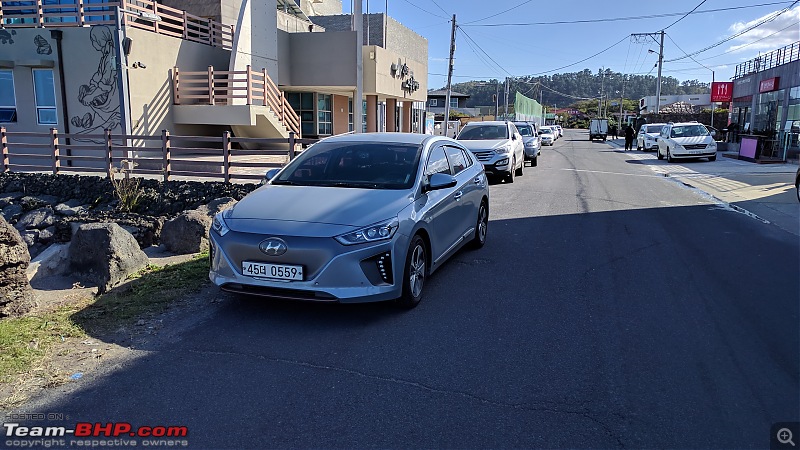
Note that there is a full electric (pictured), plug-in hybrid and regular hybrid. These are differentiated from the front grille which is closed on the electric, with grey colour and slats on the plug-in and black colour with slats on the regular hybrid. This car is giving the Toyota Prius a headache in the hybrid world.
Fantastic narration, was glued till the end. Thanks for giving us a flavour of Korea. I feel we are a generation behind in infrastructure :(
Very interesting read about a country that I rarely hear about albeit driving a Korean car. Thanks for the write-up.
It's for security reasons Google Maps is blocked in Korea. Their rather sinister northern neighbours are at striking distance from economic and technological cities of South Korea.
Nice write up. I read somewhere that Korea is full of white/Grey/ Black cars, maybe even more than India.
Japan and Korea are quite similar, all down to patriotism when buying cars as the mass market in Japan is mostly JDM as well though the Japanese seem to be more interested in cars than Koreans
Nice writeup about your observation of cars in South Korea.
Koreans use Naver search engine a lot and don't use Google much. Most of sites run on ActiveX framework and can be accessed using only Internet Explorer. Also they are paranoid of North Korean cyber attacks and want to keep everything in their country. They want to keep all that data in their own country.
A very short and crisp info about the Korean car scene.
Regarding finding Japanese cars in Korea or Korean cars in Japan, the scene is very similar. It's a strict no no. The feeling of patriotism is a bit stronger in Japan though. Japanese and Koreans do buy American or German cars, but not from the neighbouring nation. The scene is very similar for the two wheelers as well.
The sentiment is quite different for the industrial equipment though. I can comment from my experience from the shipping industry as Koreans do make ship's with lots of Japanese equipment (that's how they started). In present day, Koreans are making a lot of Japanese equipment under licence, though it's not limited to just Japanese but other popular American or European equipments as well.
Regarding auto enthusiasts, there's no nation that doesn't have them, from Cuba (the nation which has annual new car sales in single or double digits) to Japan (a nation which has the world's largest car producing manufacturer) the breed can be found everywhere;)
Wonderful narration Carmayoyi. I was on a business trip to S.Korea recently and can connect with almost all you have said. Did spot a huge Landrover-Jaguar showroom near my work place and I remember asking my local Korea colleague if he knew who owned JLR and he promptly replied Tata! No dearth of enthusiasts anywhere in the world! Also noticed local taxis using this amazing 3D type maps (so much better than Google maps). Public transport is truly beyond anything I had seen earlier, even better than few European countries.
I was in South Korea in 2013 and I can relate to all that you are saying. Though there were a lot of German cars in Seoul but towards Uljin and Donghae (where I had gone to for work) there were only Korean brands to be seen.
Their public network system is amazing, the buses connect every city and town and the metros are very efficient as well. In seoul I mostly got around by the metro and guess where I stayed in Seoul? - Gangnam (with style) ;-). One thing I did notice is that on the metro people are glued to their cell phones.
I had a bitter experience with a taxi driver - He told me the ride was 50,000Won which translates to about 50USD. I was tired from my journey and did not notice and he ended up charging me 500,000WON which is about 500USD. Thats when I decided that taxi drivers doesn't matter should not trust them anywhere.
Very good insights into the auto world of South Korea. Thank you!
The avg Indian's earnings have been growing rapidly (nearly 5 times) in the past two decades, but from a low base. But we can still see a lot of improvement in our infrastructure compared to say the 80s. Now imagine similar growth in % terms for a country where the avg citizen has been earning 6 times an Indian for at least the past 30 yrs (PPP method). All that accumulated wealth shows infrastructure and public welfare.
South Korea has a small and fairly homogenous population that perhaps makes administration easier. Relatively, India has a humongous and very diverse population that is, and (sadly) also likely to remain for decades to come, one of the poorest. So no big hopes of seeing that kind of infra in our country any time soon.










